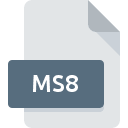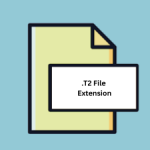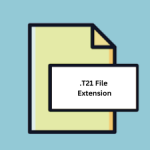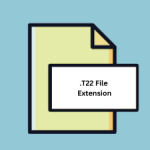.MS8 File Extension

Multisim 8 Circuit Design File
| Developer | National Instruments |
| Popularity | |
| Category | Data Files |
| Format | .MS8 |
| Cross Platform | Update Soon |
What is an MS8 file?
The .MS8 file extension is associated with Multisim 8, a powerful software tool developed by National Instruments for electronic circuit design and simulation.
Multisim 8 enables engineers, students, and hobbyists to create, analyze, and test electronic circuits in a virtual environment before physical implementation. The .MS8 files serve as containers for circuit designs created within the Multisim 8 software.
More Information.
Multisim 8 was released as an evolution of its predecessors, aiming to provide enhanced features and improved performance for circuit design and simulation tasks.
The .MS8 file extension was introduced as the default file format for saving and sharing circuit designs within the Multisim 8 ecosystem.
These files were designed to encapsulate all the necessary information related to a circuit, including component placement, wiring connections, simulation settings, and analysis results.
Origin Of This File.
The origin of the .MS8 file extension can be traced back to the development of Multisim 8 by National Instruments.
National Instruments, a leading provider of test, measurement, and control solutions, introduced Multisim 8 to cater to the growing demand for comprehensive circuit design and simulation software. With its intuitive interface and extensive component library, Multisim 8 quickly became a staple tool for electronics enthusiasts and professionals alike.
File Structure Technical Specification.
The .MS8 file format follows a structured format to store circuit design data efficiently. It typically comprises a combination of text-based information and binary data representing various elements of the circuit. The structure of an .MS8 file may include:
- Component Information: Details about the components used in the circuit, including their types, values, and properties.
- Connection Information: Information about the connections between components, specifying how they are wired together.
- Simulation Settings: Parameters and configurations for running simulations on the circuit, such as input signals, simulation types, and analysis options.
- Analysis Results: Data obtained from simulations, including waveforms, voltage/current values, and other performance metrics.
- Metadata: Additional information about the circuit design, such as authorship, creation date, and revision history.
The technical specifications of the .MS8 file format may vary slightly based on the version of Multisim being used, but they generally adhere to industry standards for circuit design file formats.
How to Convert the File?
Converting .MS8 files to other formats may be necessary to facilitate compatibility with different software platforms or to meet specific project requirements.
While direct conversion tools for .MS8 files may not be readily available, there are alternative approaches to achieve conversion:
- Export to Common Formats: Multisim 8 allows users to export circuit designs to commonly used file formats such as SPICE netlists, PCB layout files (e.g., Gerber, Eagle), and image formats (e.g., PNG, JPEG). Once exported, these files can be imported into other software tools for further processing or analysis.
- Manual Recreation: In cases where direct conversion is not feasible, users may opt to manually recreate the circuit design using alternative software tools. This approach requires a thorough understanding of the original circuit design and may be time-consuming for complex designs but offers the flexibility to adapt the design to different platforms or requirements.
- Third-Party Conversion Services: There are third-party services and software tools available that specialize in file format conversion. Users can explore these options to convert .MS8 files to desired formats, although compatibility and quality may vary depending on the specific tool used.
When choosing a conversion method, it’s essential to consider factors such as the complexity of the circuit design, compatibility requirements, and the availability of resources and expertise.
Advantages And Disadvantages.
Advantages:
- Portability: Circuit designs saved in the .MS8 format can be easily shared and transferred between users, facilitating collaboration and knowledge exchange.
- Integration: .MS8 files seamlessly integrate with other National Instruments software and hardware products, allowing for a streamlined design-to-test workflow.
- Comprehensive: The .MS8 format supports the storage of complex circuit designs, including mixed-signal circuits, programmable logic designs, and custom components.
Disadvantages:
- Compatibility: .MS8 files may not be compatible with newer versions of Multisim or other circuit design software, leading to potential issues when migrating designs across platforms.
- File Size: Complex circuit designs stored in the .MS8 format can result in large file sizes, making them cumbersome to manage and share, especially over limited bandwidth networks.
- Dependency on Software: Accessing and modifying .MS8 files require the use of Multisim or compatible software, limiting their accessibility for users without access to the appropriate tools.
How to Open MS8?
Open In Windows
- Multisim 8 is primarily designed for the Windows operating system and offers full compatibility with Windows XP, Windows Vista, and later versions. To open .MS8 files on Windows, simply launch Multisim 8 and use the “Open” command to load the desired circuit design.
Open In Linux
- Similar to MacOS, Multisim 8 does not have native support for Linux operating systems. Users can consider using compatibility layers such as Wine or running Multisim 8 within a Windows virtual machine on Linux to open .MS8 files.
Open In MAC
- While Multisim 8 is not natively supported on MacOS, users can explore alternative solutions such as running Windows virtualization software (e.g., Parallels Desktop, VMware Fusion) to install and use Multisim 8 within a virtual Windows environment. Once installed, .MS8 files can be opened using Multisim 8 as on Windows.













